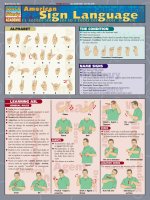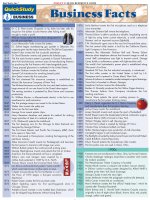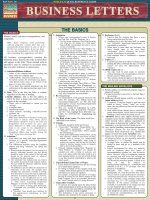BarCharts quickstudy trigonometry
Bạn đang xem bản rút gọn của tài liệu. Xem và tải ngay bản đầy đủ của tài liệu tại đây (562.16 KB, 4 trang )
BarCharts, Inc.®
WORLD’S #1 ACADEMIC OUTLINE
3. The opposite leg of a right triangle is the leg which does not touch the vertex
of the angle that is named in the trig function
x
C
4. The adjacent leg of a right triangle is the leg A
which does touch the vertex of the angle that is
named in the trig function; for example:
When evaluating the trig functions for angle A
in this right triangle, leg y is the opposite leg
y
z
for angle A because it does not touch point A;
however, leg x is the adjacent leg for angle A
because it does touch point A; the hypotenuse
B
is sidez
In the same right triangle, leg x is the opposite
leg for angle B because it does not touch point B; however, leg y is the adjacent leg for angle B because it does touch point B
(NOTICE: The leg that is the opposite leg for angle A is the same leg that is the adjacent leg for angle B, and the leg that is the adjacent leg for angle A is the same leg
that is the opposite leg for angle B; the hypotenuse is never considered as the
opposite side nor as the adjacent side because it is not a leg)
5. Since trig functions are ratios, and ratios can be written as decimal numbers,
trig functions are either converted to decimal numbers or left as radical
expressions in lowest terms (for example, 32 or .866); for example, in the right
triangles above, if:
Trigonometry (trig) means measurement of triangles; it is usually studied as measurements of sides and angles of triangles and as points on a unit circle; this study guide
is basically separated into these two main sections: trig with triangles and trig with a
unit circle; in trigonometry, the measures of angles are usually represented by letters
from the Greek alphabet; the Greek letters θ, α, ν, and β will be used throughout this
study guide to represent angle measures
TRIG WITH TRIANGLES
a=
c=hypote
leg
=
9
A. Right Triangle
1. A right triangle is a triangle with
exactly one 90º (right) angle
2. The hypotenuse is the longest side
of a right triangle, and is always
located opposite the right (90º) angle
3. The two shorter sides of a right triangle are both called legs
4. The Pythagorean Theorem (leg2+ leg2 = hypotenuse2 or a2 + b2 = c2 where a
and b are leg lengths and c is the hypotenuse length) may be used to find the
length of any third side of a right triangle when any two side lengths are known
a. When the two leg lengths
a2 + b2 = c2
are known, square the
2
length of each leg, add
9 + 162 = c2
these two squares together
81
+ 256 = c2
and square root the result337 = c2
ing sum; for example:
b=
nuse
leg
=1
√337 = c
18.36 = c = hypotenuse
6
a=leg=
8
10
b=leg
se=
nu
ote
hyp
c=
b. When the length of the
hypotenuse and either leg
are known, square the
length of the hypotenuse,
square the length of the leg,
subtract these two squares,
and square root the resulting difference; for example:
z = 9, y = 7, and x = √32 = 4√2 then
y
7 =
sin A = cos B = z =
9
x = 4√2 =
cos A = sin B = z
9
y = 7 =
tan A = x
4√2
x = 4√2 =
tan B = y
7
a2 + b 2 = c2
82 + b2 = 102
64 + b2 = 100
b2 = 100 - 64
b2 = 36
b = √36
leg = b = 6
.6285
1.2374
.8081
6. Using the trig function decimal number values to find or use angle measures
requires either a trig function chart or a calculator with trig function options;
for example, if you have found that sin α = .7778 then, by using either a trig
chart or calculator, the measure of angle α is about 51º
t degrees
•
•
•
51º 00'
10
20
30
40
50
5. Special right triangles exist that are used so often that the relationships of the
side lengths should be memorized
a. 30º-60º-90º
triangles
have side lengths with
c = hypotenuse = 2x
ratios of 1: 3 :2; that is,
b = longest leg = x√3
the longest leg is always
a = shortest leg = x
30º
3 times the length of the
b
shortest leg, and the
c If a = 5 then c = 2 • 5 = 10
hypotenuse is always 2
and b = 5 • √3 = 8.7
times the shortest leg.
If
b
=
8
then
a = 8 ÷ √3 = 4.6
This relationship can be
60º
and
c
= 2 • 8 ÷ √3 = 9.2
used to find all side
a
lengths when given only
one side length; for example:
a
b. 45º-45º-90º triangles have side
lengths with ratios of 1:1: 2 ; that is,
the two legs have the same length (if
two angles of a right triangle are
equal, then the two legs are equal),
and the hypotenuse is 2 times the
length of either leg; for example:
.7778
52º 00'
10
•
•
•
a = leg = x
b = leg = x
b
c = hypotenuse = x√2 c
If a = 7 then b = 7
and c = 7 • √2 = 9.9
If c = 12 then a = 12 ÷ √2 = 8.5
and b = 8.5
sint
•
•
•
.7771
.7790
.7808
.7826
.7844
.7862
cost
•
•
•
.6293
.6271
.6248
.6225
.6202
.6180
.7880
.6157
.7898
.6134
•
•
•
•
•
•
If using a calculator, follow the calculator directions
tant
•
•
•
1.235
1.242
1.250
1.257
1.265
1.272
1.280
1.288
•
•
•
C. Triangle Trig Applications
There are two basic ways in which trig functions are used with triangles: to find
angle measures and to find side lengths
1. Right Triangles
a. Finding Acute Angle Measures
To find the two acute angle measures A
when given two sides of a right triangle, it
82 + b2 = 202
is easiest to find the length of the third side
α
64
+ b2 = 400
20
first; for example, in the following right b
b2 = 336
triangle, if you know the length of any two
sides, then you may use the Pythagorean
β
b = √336 = 18.33
B
Theorem (leg2 + leg2 = hypotenuse2) to C
8
find the length of the third side
Once the three side lengths are found (it is not necessary to find the three side
lengths in order to find the angle measures, but it is easier), then use the trig functions
to find the degree measure of one acute angle; using the same right triangle above, the
measure of α can be found using any of the trig functions, so just pick one of them;
for example:
The measure of the second acute angle may
8
be found by simply subtracting the measure of sin α = 20 = .4000 so α = 23º 30'
the acute angle just found from 90º because the
β = 90º - 23º 30' = 66º 30'
sum of the three angles of any triangle is 180º
B. Right Triangle Trigonometry
1. The trigonometric (trig) functions of an angle are related to the ratios of the
sides of a right triangle
2. The trig functions are defined in the following manner where θ stands for
either of the acute (less than 90º) angles in the right triangle; these definitions
should be memorized:
(NOTE: The leg of the right triangle which is considered either the opposite leg or the
adjacent leg changes depending on which of the acute angles is being evaluated in
the trig function)
1
b. Finding Side Lengths
To find the side lengths of a right triangle when given only one side length and one
acute angle, first, subtract the given acute angle measure from 90º because the sum of
the three angles of any triangle is 180º; second, use the trig functions to find the length
of another side of the triangle; for example:
A
β = 90º - 35º = 55º so now we use either
acute angle with a trig function
sin35º = a
14
35º
14
or
Use a trig chart
or calculator to
b
get this decimal value.
β
B .5736 a
=
a
1
14
C
a = 14(.5736)
a = 8.0304
Use the cos 55º,
sin 55º, or cos 35º,
but not the tangent
function because
neither leg length
is given
tan 73º
Anna's height
to her eyes is
5.5 feet.
73º
h
horizontal view
4800 ft
=
3.2709
=
1
15700.32 ft =
+
5.50 ft =
15705.82 feet
above ground
h
4800
h
4800
h
Anna
d
tan 25º= 300
d
.4663 = 300
1
d
d = 643.36 ft
25º
300 ft
300 ft
water
25º is the angle of depression.
2. Oblique Triangles
Oblique triangles do not contain a right angle; therefore, any triangle that is not a
right triangle is an oblique triangle
B
a. Acute Triangles
Any acute triangle (triangle with all acute
angles) can be separated into two right triangles
by constructing a line segment from one of the
vertices and perpendicular to the side opposite
the vertex; for example, ∆ABC can be formed
into right triangles ABD and BCD by drawing
BD perpendicular to side AC
C
A
D
Then the trig function definitions for right triangles can be applied as discussed
above
(NOTE: Another option for solving acute triangles is to leave the triangles as they are
(acute) and to apply the law of cosines or the law of sines, both of which are discussed at the top of the next column)
b. Obtuse Triangles
B
Any obtuse triangle (triangle with exactly
one obtuse angle) can be converted into a right
triangle by constructing a line segment from
one of the vertices and perpendicular to the
line containing the side opposite the vertex;
for example, in ∆ABC, ∠C is obtuse; extend
side AC , then draw BD perpendicular to the A
D
C
extension; the result is right ∆ABD.
Then the trig function definitions for right triangles can be applied as discussed above
(NOTE: Another option for solving obtuse triangles is to leave the triangles as they
are (obtuse) and to apply either the law of cosines or the law of sines, both of which
are discussed at the top of the next column)
2
a
α
ν
b
C
ii. When to apply the law of cosines
The law of cosines may be used either when all three side lengths of the triangle are
known (SSS), or when only two side lengths and the measure of the angle formed by
these two sides are known (SAS, that is, two sides and the included angle)
d. Law of Sines
i. The law of sines states that in: ∆ABC (as
a = b = c
indicated in ∆ABC above in the law of
sin
α sin β sin ν
cosines):
ii. When to apply the law of sines:
The law of sines may be used either when one side length and two angle measures are
known (SAA, that is, one of the angles must be opposite the side) or when two side
lengths and one angle measure are known (SSA, that is, the angle must be opposite one
of the two sides)
iii. Caution
When using the law of sines, occasionally there will be no solution; this is because
not all combinations of angle measures and side lengths actually form triangles;
remember that the third side of any triangle must have a length longer than the difference of the other two sides and shorter than the sum of these other two sides
TRIG WITH A UNIT CIRCLE
A. Circles
1. Definitions
a. A circle is the set of points in a plane that are equidistant (the same
distance) from one point, the center of the circle (which is not actually a
point on the circle, but only the center)
b. A radius (r) is a line segment whose endpoints are a point on the circle and
the center of the circle
c. A chord is a line segment whose endpoints are both points on the circle; all
other points on the chord are points in the interior of the circle
d. A diameter (d) is a chord that contains the center of the circle
A
ii. Definition: The angle of depression is the angle formed by a horizontal line (either real or imagined) and the line of sight looking down
from the horizontal; for example:
Problem: A Coast Guard crew was flying a rescue mission in a helicopter; a member of the crew spotted a boat in trouble; this crewmember was looking down at about a 25º angle of depression; if the
helicopter was about 300 feet above water level, how far did the helicopter have to travel to be above the boat?
horizontal view
β
c
A
Once two sides of the right triangle are known, the Pythagorean Theorem can be
used to find the length of the third side
c. Applying Sample Situations
i. Definition: The angle of elevation is the angle formed by a horizontal
line (either real or imagined) and the line of sight looking up from the
horizontal; for example:
Problem: Anna stood 4,800 feet from a rocket launching pad; she
measured the angle of elevation as 73º when the rocket was at its highest point; if Anna measured the angle of elevation from a height of 5.5
feet, find the greatest height that the rocket reached
73º is the angle of elevation.
B
c. Law of Cosines
i. The law of cosines states that in a
triangle ABC:
a2 = b2 + c2 - 2bc cos α
b2 = a2 + c2 - 2ac cos β
c2 = a2 + b2 - 2ab cos ν
d
E
D
r B
C
AD is a chord.
AC is a chord and a diameter.
EB is a radius.
e. The circumference (C) of a circle is the distance around the circle, and may be
found by using the formula C =πd where π is approximately equal to 3.14
f. The area (A) of a circle is the number of square units that are needed to cover
the interior of the circle, and may be found by using the formula A =πr2
g. The arc of a circle is the set of all points on the circle between any two
points on the circle; a minor arc measures less than 180º; a semicircle is an
arc that measures exactly 180º; a major arc measures more than 180º
B. Central Angles
1. A central angle is an angle whose vertex is the center of a circle and whose
sides contain points on the circle
A
2. A central angle has the same degree measure as the circular arc it
intercepts (the arc located in the angle interior); additionally, an
arc has the same degree measure as the central angle that interB
cepts it; for example, ∠ABC intercepts arc AC and their degree
C
measure is equal
3. Degrees
a. One degree is 1/360º of the 360º contained in a complete circle; a degree may
be subdivided into 60 minutes (written 60’); a minute may be subdivided
into 60 seconds (written 60”)
b. The degree measure of an angle is the degree measure of the intercepted
circular arc of the circle for which it is a central angle
4. Radians
a. One radian is the measure of a central angle that intercepts an arc equal in
length to the radius of the circle
A
b. The radian measure of a central angle is
s
the ratio of the circular arc length to the
∠ABC = s radians
radius of the circle. Remember the disB r C
r
tance around a circle is πd; for example:
5. Degree and Radian Conversions
a. A semicircle has a degree measure of 180º and a length equal to half the circle,
.5πd or πr; the radian measure is the ratio between the circular arc length and
the radius; therefore, the radian measure of a semicircle is πr/r=π; so:
i. 180º = π radians
ii. 1 radian = 180/π
iii. 1º = π/180 radians
b. Degree and radian conversions can be accomplished using these proportions or equations:
degree measure of the angle
i. radian measure of the angle
=
π radians
180º
π (degree measure of the angle)
ii. the radian measure of an angle
=
180º
180º(radian measure of the angle)
iii. the degree measure of an angle =
π
iv. For example: If ∠A = 40º then
i.
∠A = π(40) = π(2) = 2π radians
180
9
9
The domain of the sine function is the set of real numbers; the range is
the set of real numbers between -1 and 1, inclusively; i.e., -1 ≤ y ≤ 1
y - axis
y = sin t
c. See the radians and degrees chart under the topic of Unit Circle for the
Measurements of Special Angles
C. Generated Angles
1. A generated angle (another type of angle often used in trigonometry) is a
central angle with the vertex placed at the origin of the coordinate plane, and
one of the two sides placed and kept on the positive x-axis, while the second
side is rotated in either a clockwise or counterclockwise direction
a. The side that does not rotate is called the initial side
b. The side that does rotate is called the terminal side
c. Negative angles are formed when the terminal side rotates clockwise
d. Positive angles are formed when the terminal side rotates counterclockwise
1
t - axis
-2π
π
-π
2π
3π
-1
ii. Both the domain and the range of the cosine function are the same as
the domain and the range of the sine function
y - axis
y = cos t
1
y-axis
t - axis
sid
inal
term
-2π
π
-π
2π
3π
-1
α
e
x-axis
iii. The domain of the tangent function is the set of all real numbers
except those values where the function is undefined and goes off
asymptotically, such as ± π/2, ± 3π/2, . . .
The range is the set of all real numbers; the dashed lines are the vertical asymptotes
initial side
D. Unit Circle
1. The unit circle is a circle whose center is the origin (0,0) of the rectangular coordinate plane and whose radius is equal to exactly one unit (radius = 1 and diameter = 2)
2. The equation of the unit circle is x2+ y2= 1
3. A point, P, is on the unit circle if and only if the distance from the center of the
circle to the point is equal to the radius of exactly one unit
4. The unit circle is symmetric with respect to the
y-axis
x-axis, the y-axis, and the origin; therefore, if
(-a, b)
P(a, b)
point P = (a,b) is on the unit circle, then these
points are also on the unit circle (-a,b), (-a,-b),
A(1, 0)
and (a,-b); for example:
y - axis
y = tan t
t - axis
-2π
π
-π
2π
3π
x-axis
(-a, -b)
(a, -b)
11. Periods of the functions
a. A function, f, is periodic if there is a positive number c,such that
f (t + c)=f (t) for all t in the domain of the function; this may also be stated
using x in place of the t value. The smallest value of c is called the period
of the function; that is, the smallest value at which a function begins to
repeat its range values, and thus repeat its graphing pattern, is the period of
the function
b. The period of the sine function, f (t)=sin t, is 2π because sin(t +2π)=sin t
c. The period of the cosine function, f (t)=cost, is also 2π because
cos (t +2π)=cos t
d. The period of the tangent function, f (t)=tan t, is π because tan(t +π)=tan t
(NOTE: These periods can be observed in the graphs of the functions as indicated above)
e. The period of a function, f (t)=sin Bt, is 2π/B; the effect of the value of B is
that it stretches the graph out horizontally when 0
5. The distance between any two points on the
rectangular coordinate plane may be found by using the formula:
√(x1 - x2)2 + (y1 - y2)2 where the points are (x1, y1) and (x2, y2).
6. The length of an arc of the unit circle is based on the circumference, πd = π2
= 2π; because, d=2
7. Points on the Unit Circle
a. Points can be labeled using the appropriate order pair, (x,y)
b. Points can also be labeled using the circular arc length determined by the
generated angle whose terminal side contains the point, (x,y); for example:
α
P(x, y)
P(x, y) = P(t)
t radians
r
α
y
Remember
the radius of
a unit circle
is one; r = 1
x
A(1, 0)
y
-π
2
c. Constructing a right triangle by drawing a perpendicular to the x-axis, and
determining the side lengths of the triangle results in the following unit
circle trig function definitions
8. Unit circle trig function definitions (see the diagram above):
sin t = sin α = y
Where t = radians
cos t = cos α = x
α = degrees
tan t = tan α= y ; x ≠ 0
x
NOTE: These functions are reciprocals:
1
csc t = csc α =
sin and csc; csc α = 1/sin α
y
cos and sec; sec α = 1/cos α
1
sec
t
=
sec
α
=
1
tan and cot; cot α = /tan α
x
x;y≠0
cot
t
=
cot
α
=
9. Frequently used angles and trig functions are indiy
cated in the following chart
α = degree
α
0
t
0
sin
0
cos
1
tan
0
t = radians
π
-1
2π
x
y = sin 2x; where B = 2
(NOTE: The red section of the graph indicates one period of y=sinx; and the blue
section is one period of y=sin 2x)
12. Amplitude
a. The amplitude of a trig function, y=f (t)=Asint or y=f (t)=Acost can be defined as
A
Notice that when A >1, the maximum and the minimum values of y equal A, so
the graph gets taller; likewise, when A <1, the maximum and the minimum values
of y equal A, so the graph gets shorter; in the function f (t)=Atant, the value of A does
2
Ø = undefined
y = 2sin x
1
30
45
60
90
120
135
150
180
210
225
240
270
300
315
330
360
π
6
1
2
√3
2
√3
3
π
4
√2
2
√2
2
π
3
√3
2
1
2
π
2
3π
4
√2
2
-√2
2
4π
3
-√3
2
-1
2
3π
2
7π
4
-√2
2
√2
2
Ø
-√3
-1
1
√3
Ø
-√3
-1
11π
6
-1
2
√3
2
-√3
3
2π
0
5π
3
-√3
2
1
2
√3
7π
6
-1
2
-√3
2
√3
3
5π
4
-√2
2
-√2
2
1
5π
6
1
2
-√3
2
-√3
3
π
0
2π
3
√3
2
-1
2
1
y = sin x; where B = 1
1
0
-1
0
-1
y = sin x
π
-π
0
-1
1
2π
x
y = - 1 sin x
2
-2
0
y
10. Trig function graphs
a. Graphing the values of the trig functions (indicated in the chart above) on
the t (radians) -axis and the y-axis yields the following results
affect the curve of the tangent graph, but not the maximum and the minimum values
b. The amplitude may be considered to be half the difference between the
3
TRIG WITH A UNIT CIRCLE (continued)
minimum and the maximum values
13. Phase shifts
a. The phase shift of A(t)=sin(Bx+C) or A(t)=cos(Bx+C) is -C/B
b. The phase shift indicates that the graph of the function is shifted to the
y = sin x
x
-π
π
π
-1 2
2π
3π
y = sin (2x + π)
BASIC IDENTITIES
y
right -C/B units if -C/B>0 and to the left -C/B units if -C/B<0
(NOTE: The graph of y = sin (2x+π) has a -C/B shift to the left because C=π, and B=2,
so - C/B=- π/2)
14. Inverse trig functions
a. Inverse trig functions are denoted by arc or by -1 exponents; without
restrictions on the range, the inverses of the trig functions would not be
functions themselves; notice that the range of each inverse function is a
subset of the domain of the corresponding trig function
(NOTE: sin-1x indicates the inverse function of the sine function while (sin x)-1=1/sin x,
sin-1x ≠ (sin x)-1
cos-1x ≠ (cos x)-1
-1
π
1
π
2
y
y = arcsin x = sin-1x
1
x
y = arccos x = cos-1x
-π
2
cot2t = csc2t - 1
DOUBLE - ANGLE FORMULAS
sin(-t) = -sin t
sin2t = 2sint cost
cos(-t) = cos t
cos2t = cos2t - sin2t
tan(-t) = -tan t
cos2t = 1 - 2sin2t
cos2t = 2cos2t - 1
tan2t = 2tant2
1 - tan t
1 - cos2t
sin2t =
2
1
+
cos2t
2
cos t =
2
t
√1 - cos
2
√1 +2cos t
t
√11 +- cos
cos t
y = arctan x = tan-1x
PRODUCT - SUM FORMULAS
sins cost = sin(s + t) + sin(s - t)
2
sin(s
+
t)
- sin(s - t)
coss sint =
2
coss cost = cos(s + t) + cos(s - t)
2
cos(s
t)
cos(s + t)
sins sint =
2
sins + sint = 2sin s + t cos s - t
2
2
sins - sint = 2cos s + t sin s - t
2
2
s + t cos s - t
coss + cost = 2cos
2
2
s
+
t
s
t
coss - cost = -2sin
sin
2
2
A. Trig expressions contain trig functions and relationships, but no = , < or >; they
may only be simplified;
for example: (cos x + sin x) / (sec x)
B. Trig equations contain trig functions and an equals sign; they may be solved to
find the values that make them true; algebraic techniques, such as factoring, may
=
=
or
or
or
or
sin t = ±
2
cos t = ±
2
tan t = ±
2
ANALYTIC TRIG
cos2t - cos t - 2
(cos t - 2)(cos t + 1)
cos t - 2 = 0
cos t = 2
t has no value
tan2t = sec2t - 1
HALF - ANGLE FORMULAS
x
-1
or
cot2t + 1 = csc2t
NEGATIVES
x
-π
2
sin2t = 1- cos2t
sin(s ± t) = sin s cost ± cos s sin t
s ± tan t
tan(s ± t) = tan
_
1 + tan s tan t
which is the reciprocal of the sine function; DO NOT confuse these because):
The inverse function is actually the angle measurement, y, in the range whose trig
function is equal to the real number value, x; for example, arcsin .54 = the angle whose
π
2
or
tan2t + 1 = sec2t
_
cos(s ± t) = cos s cost + sin s sin t
tan-1x ≠ (tan x)-1
RANGE
-π
-1
≤ y ≤ π
arcsin x = sin x = y if and only if sin y = x
2
2
arccos x = cos-1x = y if and only if cos y = x 0 ≤ y ≤ π
-π < y < π
arctan x = tan-1x = y if and only if tan y = x
2
2
y
tant =sin t
cos t
sin2t + cos2t = 1
ADDITION / SUBTRACTION FORMULAS
INVERSE FUNCTION
y
cos ( π - t) = sin t
2
π
sin (
- t) = cos t
2
tan ( π - t) = cot t
2
1
csc t =
sin t
1
sec t =
cos t
1
cot t =
tan t
1
-2π
COFUNCTIONS
RECIPROCALS
0 can be factored as
0 then
cos t + 1 = 0
cos t = -1 so in the interval 0 ≤ t ≤ 2π
t =π
( ) (
( ) (
( ) (
( ) (
be used to solve trig equations; for example:
C. Trig identities are true for all real numbers in the domain; they may be proven or
varified; methods of proving or verifying identities include working the left side of
the equation only until it is identical to the right side; working the right side until it
is identical to the left side; or, working both sides until they are identical
D. Fundamental Trig Identities and Formulas
)
)
)
)
CREDITS
Author: Dr. S. B. Kizlik
Artwork: Michael D. Adam
Layout: Michael D. Adam
hundreds of titles at
U.S.$4.95 / CAN.$7.50
quickstudy.com
NOTE TO STUDENT
DISCLAIMER This guide is intended only for informational purposes, and is not
meant to be a substitute for professional sports instruction. Due to its condensed
format, this guide cannot cover every aspect of this sport. Neither BarCharts®, its
writers, designers nor editing staff, are in any way responsible or liable for the use or
misuse of the information contained in this guide.
All rights reserved. No part of this publication may be reproduced or transmitted in
any form, or by any means, electronic or mechanical, including photocopy, recording,
or any information storage and retrieval system, without written permission from
the publisher.
© 2002, 2005 BarCharts Inc. 1105
Customer Hotline # 1.800.230.9522
We welcome your feedback so we can
maintain and exceed your expectations.
4









